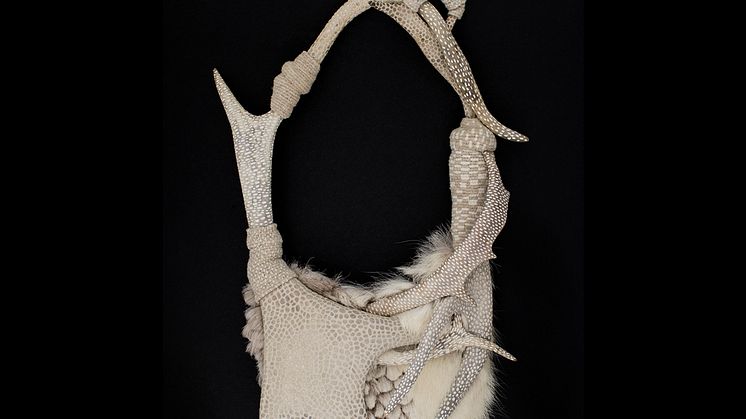
Press release -
New acquisition: North necklace by Hanna Hedman
Nationalmuseum has acquired a necklace created in 2015 by Hanna Hedman (born 1980). North is made from reindeer hide, sheepskin, and reindeer, moose and deer antler. The materials reflect the artist’s Norrbotten connections. Hanna Hedman is also featured in Nationalmuseum’s Transformations exhibition, which opens soon in Venice.
The materials are central to Hanna Hedman’s North necklace, one in a series of eight works she created between 2014 and 2016. Hedman chose materials with a long handicraft tradition in the far north, reflecting her affinity for the Norrbotten region, where she attended upper secondary school in Älvsbyn. She experimented with materials that were new to her, including birch bark, reindeer hide, curly birch, flax, and moose and reindeer antler. Not only were these materials appropriate in the cultural context, but they were also locally sourced in northern Sweden.
The necklace acquired by Nationalmuseum is made of reindeer hide, sheepskin, and reindeer, moose and deer antler. A decorative pattern of dots has been carved into the antler, and part of the reindeer hide has been cut to produce a similar effect. Hedman joined the pieces together with braided flax using a traditional basket-weaving technique from Africa and North America, but instead of grass she used organic flax yarn from Hälsingland.
Hedman’s jewellery art is inspired by nature and deals mainly with dark themes such as sorrow and death. On closer inspection, seemingly beautiful forms turn out to be repulsive body parts made from metal. Hedman’s Enough Tears to Cry for Two necklace, which reaches all the way to the floor, is about deep sorrow. In North too there are allusions to life and death, and to excessive human exploitation of natural resources. Hedman emphasises that the antler was naturally shed, and that the hide was purchased from reindeer herders in Jokkmokk.
The purchase of this work was made possible by a generous donation from the Friends of Nationalmuseum and the Bengt Julin Fund. Nationalmuseum has no budget of its own for new acquisitions, but relies on gifting and financial support from private funds and foundations to enhance its collections of fine art and craft.
Nationalmuseum and jewellery art
Nationalmuseum has a keen interest in the Swedish contemporary jewellery scene and seeks to reflect the latest developments in its exhibitions and acquisitions.
Pieces by Hanna Hedman are included in Nationalmuseum’s Transformations exhibition, featuring the work of six contemporary jewellery artists from Sweden, which runs at the Musei de Palazzo Mocenigo during the Venice Biennale from 13 May to 1 October 2017. The other featured artists are Tobias Alm, Sara Borgegård Älgå, Catarina Hällzon, Agnes Larsson and Märta Mattsson.
Through this exhibition, Nationalmuseum hopes to stimulate new connections and dialogue between contemporary art and jewellery art. Jewellery art is strongly engaged in issues that art has long been concerned with: identity, gender, body, materiality and nature. But it has an added dimension: the living, moving body wearing the jewellery. A body belonging to a person with specific experiences of prejudice, love, joy and sorrow. A body that makes contemporary jewellery art a unique field of visual and material culture.
Inventory number
NMK 198/2016
More information
Cilla Robach, Senior Curator: +46 8 5195 4305, cilla.robach@nationalmuseum.se
Mattias Robertson, Press Officer: +46 767 234632, press@nationalmuseum.se
Categories
Nationalmuseum is Sweden’s premier museum of art and design. The collections comprise older paintings, sculpture, drawings and graphic art, and applied art and design up to the present day. The museum building is currently under renovation and scheduled to open again in 2018. In the meantime, the museum will continue its activities through collaborations both in Sweden and abroad as well as temporary exhibitions at Nationalmuseum Design at Kulturhuset Stadsteatern in Stockholm. Nationalmuseum has partnerships with Svenska Dagbladet and the Grand Hôtel Stockholm, and acknowledges the support of FCB Fältman & Malmén.

